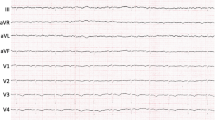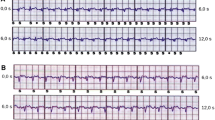Abstract
The subcutaneous implantable cardioverter-defibrillator (S-ICD) may provide comparable protection while avoiding the disadvantage of transvenous lead, but the abnormal features of the hypertrophic cardiomyopathy (HCM) electrocardiogram (ECG) make it a challenge for S-ICD template screening. We aimed to investigate S-ICD eligibility according to the S-ICD manufacturer’s surface ECG screening template in China, and further analyze its corresponding ineligible predicting factors in 12-lead suface ECG. A total of 179 HCM patients (114 males; mean age: 45 ± 14 years) underwent S-ICD screening at rest and on exercise, among which 91 patients (50.8%) were eligible for S-ICD. Among the patients who passed screening, 43 (47.3%) had 3 vectors eligibility; 64 (70.3%) screening qualified on both sides; 10 patients (11.0%) passed the screening while the electrodes located only on the left parasternal line versus 17 patients (18.7%) moved to the right line. The secondary sensing vector (Lead III) was mostly appropriate (53.6%), followed by the primary sensing vector (lead II, 53.1%) and the alternate sensing vector (Lead I, 46.9%). Higher R wave was the major cause, accounted for 70.5%, for screening failure. There existed significant difference in T wave in lead II, aVF, V5 and V6, adds R/T ratio in lead V5 and V6, between the screening success group (group A) and screening failure group (group B) at rest and on exercise. A multivariable logistic regression analysis was performed to identify that R/T ≤ 3.5 in lead V5 was the independent factor to predict the screening ineligibility, with odds ratio 3.648. S-ICD screening success is 50.8% in HCM patients, which is much lower than that in other studies. R/T ≤ 3.5 in lead V5 in 12-lead surface ECG was an independent predicting factor for screening failure.





Similar content being viewed by others
References
Baudhuin LM, Kotzer KE, Kluge ML, Maleszewski JJ (2015) What is the true prevalence of hypertrophic cardiomyopathy? J Am Coll Cardiol 66(16):1845–1846
Maron BJ, Rowin EJ, Casey SA, Link MS, Lesser JR, Chan RH, Garberich RF, Udelson JE, Maron MS (2015) Hypertrophic cardiomyopathy in adulthood associated with low cardiovascular mortality with contemporary management strategies. J Am Coll Cardiol 65(18):1915–1928
Rhyner J, Knight PB (2014) Totally subcutaneous implantable defibrillator. Cardiol Clin 32(2):225–237
Lambiase PD, Gold MR, Hood M, Boersma L, Theuns DA, Burke MC, Weiss R, Russo AM, Kaab S, Knight BP (2016) Evaluation of subcutaneous ICD early performance in hypertrophic cardiomyopathy from the pooled EFFORTLESS and IDE cohorts. Heart Rhythm 13(5):1066–1074
Maurizi N, Olivotto I, Olde Nordkamp LR, Baldini K, Fumagalli C, Brouwer TF, Knops RE, Cecchi F (2016) Prevalence of subcutaneous implantable cardioverter-defibrillator candidacy based on template ECG screening in patients with hypertrophic cardiomyopathy. Heart Rhythm 13(2):457–463
Weinstock J, Bader YH, Maron MS, Rowin EJ, Link MS (2016) Subcutaneous implantable cardioverter defibrillator in patients with hypertrophic cardiomyopathy: an initial experience. J Am Heart Assoc 5(2):e002488
Authors/Task Force members, Elliott PM, Anastasakis A, Borger MA, Borggrefe M, Cecchi F, Charron P, Hagege AA, Lafont A, Limongelli G, Mahrholdt H, McKenna WJ, Mogensen J Nihoyannopoulos P, Nistri S, Pieper PG Pieske B, Rapezzi C, Rutten FH, Tillmanns C, Watkins H (2014) 2014 ESC Guidelines on diagnosis and management of hypertrophic cardiomyopathy. The Task Force for the Diagnosis and Management of Hypertrophic Cardiomyopathy of the European Society of Cardiology (ESC). Eur Heart J 35(39):2733-2739.
Ip JE, Wu MS, Kennel PJ, Thomas G, Liu CF, Cheung JW, Markowitz SM, Lerman BB (2017) Eligibility of pacemaker patients for subcutaneous implantable cardioverter defibrillators. J Cardiovasc Electrophysiol 28(5):544–548
Maron BJ, Olivotto I, Spirito P, Casey SA, Bellone P, Gohman TE, Graham KJ, Burton DA, Cecchi F (2000) Epidemiology of hypertrophic cardiomyopathy-related death: revisited in a large non-referral-based patient population. Circulation 102(8):858–864
Thavikulwat AC, Tomson TT, Knight BP, Bonow RO, Choudhury L (2016) Appropriate implantable defibrillator therapy in adults with hypertrophic cardiomyopathy. J Cardiovasc Electrophysiol 27(8):953–960
Maron BJ (2010) Risk stratification and role of implantable defibrillators for prevention of sudden death in patients with hypertrophic cardiomyopathy. Circ J 74(11):2271–2282
O'Mahony C, Lambiase PD, Quarta G, Cardona M, Calcagnino M, Tsovolas K, Al-Shaikh S, Rahman SM, Arnous S, Jones S, McKenna W, Elliott P (2011) The long-term survival and the risks and benefits of implantable cardioverter defibrillators in patients with hypertrophic cardiomyopathy. Heart 98(2):116–125
Lin G, Nishimura RA, Gersh BJ, Phil D, Ommen SR, Ackerman MJ, Brady PA (2009) Device complications and inappropriate implantable cardioverter defibrillator shocks in patients with hypertrophic cardiomyopathy. Heart 95(9):709–714
Olde Nordkamp LRA, Warnaars JLF, Kooiman KM, de Groot JR, Bram Rosenmoller, Wilde AAM, Knops RE (2014) Which patients are not suitable for a subcutaneous ICD: incidence and predictors of failed QRS-T-wave morphology screening. J Cardiovasc Electrophysiol 25(5):494–499
Francia P, Adduci C, Palano F, Semprini L, Serdoz A, Montesanti D, Santini D, Musumeci B, Salvati A, Volpe M, Autore C (2015) Eligibility for the subcutaneous implantable cardioverter-defibrillator in patients with hypertrophic cardiomyopathy. J Cardiovasc Electrohpysiol 26(8):893–899
Randles DA, Hawkins NM, Shaw M, Patwala AY, Pettit SJ, Wright DJ (2014) How many patients fulfil the surface electrocardiogram criteria for subcutaneous implantable cardioverter-defibrillator implantation? Europace 16(7):1015–1021
Acknowledgements
We specifically thank Professor Changsheng Chen for his guidance and support mainly in statistical analysis.
Author information
Authors and Affiliations
Corresponding authors
Ethics declarations
Conflicts of interest
The authors declare that they have no conflicts of interest.
Rights and permissions
About this article
Cite this article
Guo, L., Zhang, M., Hu, M. et al. Prevalence of subcutaneous implantable cardioverter-defibrillator based on template ECG screening and ineligible surface ECG predicting factors in patients with hypertrophic cardiomyopathy in China. Heart Vessels 34, 851–859 (2019). https://doi.org/10.1007/s00380-018-1300-8
Received:
Accepted:
Published:
Issue Date:
DOI: https://doi.org/10.1007/s00380-018-1300-8




